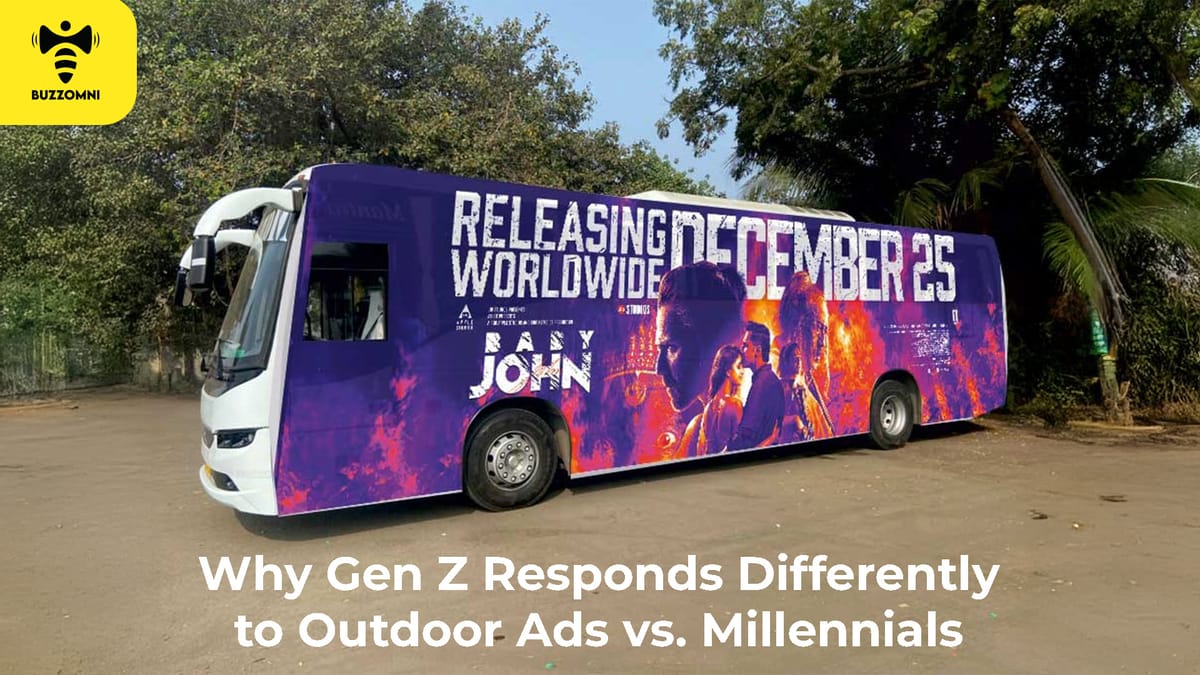Gen Z vs. Millennials: How Outdoor Advertising Speaks to Each Generation
Gen Z and Millennials respond differently to outdoor advertising. While Millennials value credibility and consistency, Gen Z seeks creativity, interactivity, and shareable experiences. Understanding these differences is key to effective campaigns.

Table of Contents
- Introduction
- The Generational Context
- Outdoor Advertising and Millennials
- Outdoor Advertising and Gen Z
- Cinema Advertising: A Shared Space
- Why the Difference Matters
- Final Thoughts
Introduction
In today’s fast-changing media landscape, brands face the challenge of connecting with two highly influential generations: Gen Z and Millennials. While both grew up in the digital era, their relationship with out of home media advertising—from advertising billboards to cinema advertising—is surprisingly different. At BuzzOmni, we believe understanding these nuances can help marketers craft campaigns that resonate more effectively across age groups.
The Generational Context
Millennials, born between 1981 and 1996, witnessed the transition from analog to digital. They remember traditional television advertising, print campaigns, and the rise of early internet marketing. Their brand loyalty often stems from emotional storytelling and consistent exposure across multiple channels.
Gen Z, on the other hand, are true digital natives. Born between 1997 and 2012, they’ve grown up immersed in smartphones, social media, and instant content. Their attention spans are shorter, but their ability to filter messages is sharper. They value authenticity, interactivity, and experiences over passive consumption.
This generational divide is critical when considering how they respond to outdoor advertising and its various formats.
Outdoor Advertising and Millennials
For Millennials, advertising in billboards carries a sense of nostalgia and credibility. Many Millennials still commute to work daily and interact with transit advertising on buses, trains, and subways. For them, transport advertising and static advertising billboards remain familiar touchpoints, reminding them of brands they grew up with.
Millennials are also more receptive to integrated campaigns that connect outdoor channels with digital engagement. For instance, a billboard paired with a QR code linking to an app discount or event invitation appeals to their sense of convenience and brand utility.
Outdoor Advertising and Gen Z
Gen Z responds differently. While they are constantly connected online, they crave real-world experiences. OOH advertising—when done creatively—breaks through the digital noise. A bold, interactive advertising billboard or dynamic cinema advertising before a blockbuster screening can feel refreshing and more trustworthy compared to the flood of online ads.
However, Gen Z demands more than visibility. They want outdoor campaigns to be engaging, Instagram-worthy, and socially conscious. For example, transport advertising that doubles as a moving art installation or billboards that use real-time data to change messages grab their attention. Unlike Millennials, they are more likely to share such experiences on social platforms, amplifying the brand organically.
Cinema Advertising: A Shared Space
Interestingly, cinema advertising bridges the generational gap. Both Millennials and Gen Z enjoy moviegoing as a social activity. While Millennials may appreciate longer-form storytelling in cinema ads, Gen Z prefers humor, bold visuals, and interactive prompts, like QR codes leading to exclusive content. This shared environment makes cinema a unique space where brands can tailor messaging to both audiences without losing relevance.
Why the Difference Matters
The generational differences highlight that outdoor advertising is not one-size-fits-all. For Millennials, it’s about consistency, credibility, and nostalgia. For Gen Z, it’s about creativity, authenticity, and shareability.
Brands that use out of home media advertising effectively understand these dynamics and diversify their strategies. For instance:
- For Millennials: Blend television advertising with advertising in billboards to maintain familiarity and trust.
- For Gen Z: Invest in experiential transit advertising and interactive billboards that invite social sharing.
Final Thoughts
As the marketing landscape evolves, outdoor advertising remains a powerful medium precisely because it cuts through the clutter of digital oversaturation. Yet, its impact depends on how well brands adapt their messaging to generational preferences. Millennials want reassurance and utility, while Gen Z seeks engagement and cultural alignment.
For marketers, the future of OOH advertising lies not just in visibility but in relevance. Whether through transport advertising, cinema advertising, or the traditional advertising billboard, success comes from crafting campaigns that meet each generation where they are—physically and emotionally. At BuzzOmni, we help brands bridge this gap with strategies that make outdoor media truly resonate.



